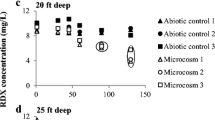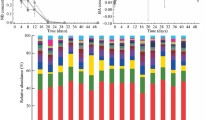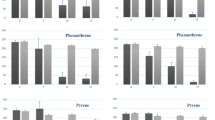Abstract
Considerable amount of gasoline from natural and anthropogenic sources, such as urban runoff during hurricanes and oil discharges from pleasure crafts, has been released into Lake Pontchartrain, Louisiana, which poses a threat to the lake marsh ecosystems. In this research, we evaluated the impact of gasoline on indigenous bacterial communities in three types of marsh sediments collected from the Lake Pontchartrain. Our data show that several bacterial species are significantly enriched in gasoline-treated sediments. DNA sequencing data indicate that the enriched bacteria in response to the gasoline treatment are Acidocella and Burkholderia spp. in freshwater marsh; Mariprofundus, Nitrosospira, and Ferrimicrobium spp. in brackish marsh; and three Pseudomonas spp. in salt marsh. Our research will help to understand a gasoline bioremediation by indigenous bacteria and to develop site-specific bioremediation strategies for the Lake Pontchartrain.



Similar content being viewed by others
References
Altschul, S. F., Gish, W., Miller, W., Myers, E. W., & Lipman, D. J. (1990). Basic local alignment search tool. Journal of Molecular Biology, 215(3), 403–410.
Balashova, N. V., Kosheleva, I. A., Golovchenko, N. P., & Boronin, A. M. (1999). Phenanthrene metabolism by Pseudomonas and Burkholderia strains. Process Biochemistry, 35, 291–296.
Belhaj, A., Desnoues, N., & Elmerich, C. (2002). Alkane biodegradation in Pseudomonas aeruginosa strains isolated from a polluted zone: identification of alkB and alkB-related genes. Research in Microbiology, 153(6), 339–344.
Bombach, P., Chatzinotas, A., Neu, T. R., Kästner, M., Lueders, T., & Vogt, C. (2010). Enrichment and characterization of a sulfate-reducing toluene-degrading microbial consortium by combining in situ microcosms and stable isotope probing techniques. FEMS Microbiology Ecology, 71(2), 237–246.
Bundy, J. G., Paton, G. I., & Campbell, C. D. (2002). Microbial communities in different soil types do not converge after diesel contamination. Journal of Applied Microbiology, 92(2), 276–288.
Burri, J., Crockett, R., Hany, R., & Rentsch, D. (2004). Gasoline composition determined by H NMR spectroscopy. Fuel, 83, 187–193.
Cameron, F. J., Jones, M. V., & Edwards, C. (1984). Effects of salinity on bacterial iron oxidation. Current Microbiology, 10(6), 353–356.
Chikere, C. B., Okpokwasili, G. C., & Chikere, B. O. (2009). Bacterial diversity in a tropical crude oil-polluted soil undergoing bioremediation. African Journal of Biotechnology, 8(11), 2535–2540.
Chikere, C. B., Okpokwasili, G. C., & Chikere, B. O. (2011). Monitoring of microbial hydrocarbon remediation in the soil.3. Biotech, 1(3), 117–138.
Da Silva, A. C., de Oliveira, F. J. S., Bernardes, D. S., & de França, F. P. (2009). Bioremediation of marine sediments impacted by petroleum. Applied Biochemistry and Biotechnology, 153, 58–66.
Das, K., & Mukherjee, A. K. (2007). Crude petroleum-oil biodegradation efficiency of Bacillus subtilis and Pseudomonas aeruginosa strains isolated from a petroleum-oil contaminated soil from north-east India. Bioresource Technology, 98(7), 1339–1345.
Deni, J., & Penninckx, M. J. (1999). Nitrification and autotrophic nitrifying bacteria in a hydrocarbon-polluted soil. Applied and Environmental Microbiology, 65(9), 4008–4013.
Department of Natural Resources, State of Louisiana. (1995). Sources and impacts of pollution in Lake Pontchartrain. http://dnr.louisiana.gov/index.cfm?md=pagebuilder&tmp=home&pid=269. Accessed 1 January 2014.
Dietrich, J. C., Trahan, C. J., Howard, M. T., Fleming, J. G., Weaver, R. J., Tanaka, S., et al. (2012). Surface trajectories of oil transport along the northern coastline of the Gulf of Mexico. Continental Shelf Research, 41, 17–47.
Dore, S. Y., Clancy, Q. E., Rylee, S. M., & Kulpa, C. F. (2003). Naphthalene-utilizing and mercury-resistant bacteria isolated from an acidic environment. Applied Microbiology and Biotechnology, 63(2), 194–199.
Dos Santos, H. F., Cury, J. C., do Carmo, F. L., dos Santos, A. L., Tiedje, J., van Elsas, J. D., et al. (2011). Mangrove bacterial diversity and the impact of oil contamination revealed by pyrosequencing: Bacterial proxies for oil pollution. PLoS ONE, 6(3), e16943.
Ekpo, M. A., & Ebeagwu, C. J. (2009). The effect of crude oil on microorganisms and dry matter of fluted pumpkin (Telfairiaoccidentalis). Scientific Research and Essays, 4(8), 733–739.
Grenni, P., Falconi, F., & Caracciolo, A. B. (2012). Microcosm experiments for evaluating natural bioremediation of contaminated ecosystems. Chemical Engineering, 28, 7–12.
Hamamura, N., Olson, S. H., Ward, D. M., & Inskeep, W. P. (2005). Diversity and functional analysis of bacterial communities associated with natural hydrocarbon seeps in acidic soils at Rainbow Springs, Yellowstone National Park. Applied and Environmental Microbiology, 71(10), 5943–5950.
Hazen, T. C., Dubinsky, E. A., DeSantis, T. Z., Andersen, G. L., Piceno, Y. M., Singh, N., et al. (2010). Deep-sea oil plume enriches indigenous oil-degrading bacteria. Science, 330(6001), 204–208.
Herrmann, S., Kleinsteuber, S., Chatzinotas, A., Kuppardt, S., Lueders, T., Richnow, H.-H., et al. (2010). Functional characterization of an anaerobic benzene-degrading enrichment culture by DNA stable isotope probing. Environmental Microbiology, 12(2), 401–411.
Hollaway, S. L., Faw, G. M., & Sizemore, R. K. (1980). The bacterial community composition of an active oil field in the northwestern Gulf of Mexico. Marine Pollution Bulletin, 11(6), 153–156.
Hosokawa, R., Sakaguchi, N., & Okuyama, H. (2010). Establishment and characterization of turbine oil-degrading bacterial consortia. International Biodeterioration and Biodegradation, 64(6), 519–524.
Huang, X., Tian, Y., Luo, Y. R., Liu, H. J., Zheng, W., & Zheng, T. L. (2008). Modified sublimation to isolate phenanthrene-degrading bacteria of the genera Sphingomonas and Burkholderia from Xiamen oil port. Marine Pollution Bulletin, 57, 538–543.
Huber, H., & Stetter, K. O. (1989). Thiobacillus prosperus sp. nov., represents a new group of halotolerant metal-mobilizing bacteria isolated from a marine geothermal field. Archives of Microbiology, 151(6), 479–485.
Husain, S. (2008). Literature overview: microbial metabolism of high molecular weight polycyclic aromatic hydrocarbons. Remediation Journal, 18(2), 131–161.
Hyman, M. R., Murton, I. B., & Arp, D. J. (1988). Interaction of ammonia monooxygenase from Nitrosomonaseuropaea with alkanes, alkenes, and alkynes. Applied and Environmental Microbiology, 54(12), 3187–3190.
Jain, P. K., Gupta, V. K., Gaur, R. K., Lowry, M., Jaroli, D. P., & Chauhan, U. K. (2011). Bioremediation of petroleum oil contaminated soil and water. Research Journal of Environmental Toxicology, 5(1), 1–26.
Johnson, D. B., Bacelar-Nicolau, P., Okibe, N., Thomas, A., & Hallberg, K. B. (2009). Ferrimicrobium acidiphilum gen. nov., sp. nov. and Ferrithrixthermotoleransgen. nov., sp. nov.: Heterotrophic, iron-oxidizing, extremely acidophilic actinobacteria. International Journal of Systematic and Evolutionary Microbiology, 59(5), 1082–1089.
Juwarkar, A. A., Singh, S. K., & Mudhoo, A. (2010). A comprehensive overview of elements in bioremediation. Reviews in Environmental Science and Biotechnology, 9(3), 215–288.
Karamalidis, A. K., Evangelou, A. C., Karabika, E., Koukkou, A. I., Drainas, C., & Voudrias, E. A. (2010). Laboratory scale bioremediation of petroleum-contaminated soil by indigenous microorganisms and added Pseudomonas aeruginosa strain Spet. Bioresource Technology, 101(16), 6545–6552.
Keener, W. K., & Arp, D. J. (1994). Transformations of aromatic compounds by Nitrosomonaseuropaea. Applied and Environmental Microbiology, 60(6), 1914–1920.
Khan, N. H., Ishii, Y., Kimata-Kino, N., Esaki, H., Nishino, T., Nishimura, M., et al. (2007). Isolation of Pseudomonas aeruginosa from open ocean and comparison with freshwater, clinical, and animal isolates. Microbial Ecology, 53(2), 173–186.
Kim, S.-J., Park, S.-J., Cha, I.-T., Min, D., Kim, J.-S., Chung, W.-H., et al. (2014). Metabolic versatility of toluene-degrading, iron-reducing bacteria in tidal flat sediment, characterized by stable isotope probing-based metagenomic analysis. Environmental Microbiology, 16(1), 189–204.
Kostka, J. E., Prakash, O., Overholt, W. A., Green, S. J., Freyer, G., Canion, A., et al. (2011). Hydrocarbon-degrading bacteria and the bacterial community response in Gulf of Mexico beach sands impacted by the Deepwater Horizon oil spill. Applied and Environmental Microbiology, 77(22), 7962–7974.
Kunapuli, U., Lueders, T., & Meckenstock, R. U. (2007). The use of stable isotope probing to identify key iron-reducing microorganisms involved in anaerobic benzene degradation. The ISME Journal, 1(7), 643–653.
Kurola, J., Wittmann, C., Salkinoja-Salonen, M., Aarnio, T., & Romantschuk, M. (2005a). Application of cation-exchange membranes for characterisation and imaging ammonia-oxidising bacteria in soils. FEMS Microbiology Ecology, 53(3), 463–472.
Kurola, J., Salkinoja-Salonen, M., Aarnio, T., Hultman, J., & Romantschuk, M. (2005b). Activity, diversity and population size of ammonia-oxidising bacteria in oil-contaminated landfarming soil. FEMS Microbiology Letters, 250(1), 33–38.
Laanbroek, H. J., Keijzer, R. M., Verhoeven, J. T. A., & Whigham, D. F. (2012). The distribution of ammonia-oxidizing betaproteobacteria in stands of Black Mangroves (Avicenniagerminans). Frontiers in Microbiology, 3(153), 1–11.
Laurie, A. D., & Lloyd-Jones, G. (1999). Conserved and hybrid meta-cleavage operons from PAH-degrading Burkholderia RP007. Biochemical and Biophysical Research Communications, 262(1), 308–314.
Łebkowska, M., Zborowska, E., Karwowska, E., Miaśkiewicz-Pęska, E., Muszyński, A., Tabernacka, A., et al. (2011). Bioremediation of soil polluted with fuels by sequential multiple injection of native microorganisms: field-scale processes in Poland. Ecological Engineering, 37(11), 1895–1900.
Lin, S. Y., Hameed, A., Liu, Y. C., Hsu, Y. H., Lai, W. A., Chen, W. M., et al. (2012). Pseudomonas sagittaria sp. nov., a novel siderophore-producing bacterium isolated from oil-contaminated soil. International Journal of Systematic and Evolutionary Microbiology, 63(7), 2410–2417.
Liu, W., Luo, Y., Teng, Y., Li, Z., & Ma, L. Q. (2010). Bioremediation of oily sludge-contaminated soil by stimulating indigenous microbes. Environmental Geochemistry and Health, 32(1), 23–29.
Liu, P. W. G., Chang, T. C., Whang, L. M., Kao, C. H., Pan, P. T., & Cheng, S. S. (2011). Bioremediation of petroleum hydrocarbon contaminated soil: effects of strategies and microbial community shift. International Biodeterioration and Biodegradation, 65(8), 1119–1127.
Lu, Z., Deng, Y., Nostrand, J. D. V., He, Z., Voordeckers, J., Zhou, A., et al. (2011). Microbial gene functions enriched in the deepwater horizon deep-sea oil plume. The ISME Journal, 6(2), 451–460.
MacNaughton, S. J., Stephen, J. R., Venosa, A. D., Davis, G. A., Chang, Y. J., & White, D. C. (1999). Microbial population changes during bioremediation of an experimental oil spill. Applied and Environmental Microbiology, 65(8), 3566–3574.
Madueño, L., Coppotelli, B. M., Alvarez, H. M., & Morelli, I. S. (2011). Isolation and characterization of indigenous soil bacteria for bioaugmentation of PAH contaminated soil of semiarid Patagonia, Argentina. International Biodeterioration and Biodegradation, 65(2), 345–351.
Manuel, J. (2006). In Katrina’s wake. Environmental Health Perspectives, 114(1), A32–A39.
Marin, J. A., Hernandez, T., & Garcia, C. (2005). Bioremediation of oil refinery sludge by land farming in semiarid conditions: influence on soil microbial activity. Environmental Research, 98(2), 185–195.
Maruyama, A., Ishiwata, H., Kitamura, K., Sunamura, M., Fujita, T., Matsuo, M., et al. (2003). Dynamics of microbial populations and strong selection for Cycloclasticus pugetii following the Nakhodka oil spill. Microbial Ecology, 46(4), 442–453.
McBeth, J. M., Little, B. J., Ray, R. I., Farrar, K. M., & Emerson, D. (2011). Neutrophilic iron-oxidizing “zetaproteobacteria” and mild steel corrosion in nearshore marine environments. Applied and Environmental Microbiology, 77(4), 1405–1412.
Militon, C., Boucher, D., Vachelard, C., Perchet, G., Barra, V., Troquet, J., et al. (2010). Bacterial community changes during bioremediation of aliphatic hydrocarbon-contaminated soil. FEMS Microbiology Ecology, 74(3), 669–681.
Mrozik, A., & Piotrowska-Seget, Z. (2010). Bioaugmentation as a strategy for cleaning up of soils contaminated with aromatic compounds. Microbiological Research, 165(5), 363–375.
Muyzer, G., de Waal, E. C., & Uitterlinden, A. G. (1993). Profiling of complex microbial populations by denaturing gradient gel electrophoresis analysis of polymerase chain reaction-amplified genes coding for 16SrRNA. Applied and Environmental Microbiology, 59, 695–700.
Nakagawa, S., & Takai, K. (2008). Deep-sea vent chemoautotrophs: diversity, biochemistry and ecological significance. FEMS Microbiology Ecology, 65(1), 1–14.
Norton, J. M., Alzerreca, J. J., Suwa, Y., & Klotz, M. G. (2002). Diversity of ammonia monooxygenase operon in autotrophic ammonia-oxidizing bacteria. Archives of Microbiology, 177(2), 139–149.
Office of the Governor, State of Louisiana. (2013). Governor Jindal and Parkway Pipeline announce upcoming completion of $230 million energy pipeline project. http://gov.la.gov/index.cfm?md=newsroom&tmp=detail&catID=2&articleID=4196&navID=3.Accessed 1 January 2014.
Oka, A. R., Phelps, C. D., McGuinness, L. M., Mumford, A., Young, L. Y., & Kerkhof, L. J. (2008). Identification of critical members in a sulfidogenic benzene-degrading consortium by DNA stable isotope probing. Applied and Environmental Microbiology, 74(20), 6476–6480.
Park, J. W., & Crowley, D. E. (2005). Normalization of soil DNA extraction for accurate quantification of target genes by real-time PCR and DGGE. Biotechniques, 38(4), 579–586.
Powers, J. P., Corwin, A. B., Schmall, P. C., & Kaeck, W. E. (2007). Groundwater chemistry, bacteriology, and fouling of dewatering systems. In J. P. Powers (Ed.), Construction dewatering and groundwater control (pp. 195–221). New Jersey: John Wiley & Sons, Inc.
Prince, R. C. (2003). Petroleum and other hydrocarbons, biodegradation of. Encyclopedia of Environmental Microbiology. New Jersey: John Wiley.
Pucci, O. H., Bak, M. A., Peressutti, S. R., Klein, I., Härtig, C., Alvarez, H. M., et al. (2000). Influence of crude oil contamination on the bacterial community of semiarid soils of Patagonia (Argentina). Acta Biotechnologica, 20(2), 129–146.
Röling, W. F. M., Ortega-Lucach, S., Larter, S. R., & Head, I. M. (2006). Acidophilic microbial communities associated with a natural, biodegraded hydrocarbon seepage. Journal of Applied Microbiology, 101(2), 290–299.
Sawyer, R. F. (1993). Trends in auto emissions and gasoline composition. Environmental Health Perspectives Supplements, 101(6), 5–12.
Shailubhai, K., Rao, N. N., & Modi, V. V. (1985). Degradation of petroleum industry oil sludge by Rhodotorularubra and Pseudomonas aeruginosa. Oil and Petrochemical Pollution, 2(2), 133–136.
Singer, E., Emerson, D., Webb, E. A., Barco, R. A., Kuenen, J. G., Nelson, W. C., et al. (2011). Mariprofundus ferrooxydans PV-1 the first genome of a marine Fe(II) oxidizing Zetaproteobacterium. PLoS ONE, 6(9), e25386.
Smalla, K., Wieland, G., Buchner, A., Zock, A., Parzy, J., Kaiser, S., et al. (2001). Bulk and rhizosphere soil bacterial communities studied by denaturing gradient gel electrophoresis: plant-dependent enrichment and seasonal shifts revealed. Applied and Environmental Microbiology, 67(10), 4742–4751.
Speight, J. G., & Arjoon, K. K. (2012). Biodegradation of petroleum. In J. G. Speight (Ed.), Bioremediation of Petroleum and Petroleum Products (pp. 305–359). Massachusetts: Wiley-Scrivener.
Summer, N. (2012). Bacteriophage replacement of chemicals biocides in deepwater pipelines and reservoirs: a proof of concept study. http://www.netl.doe.gov/technologies/oil-gas/publications/EPact/08121-2902-04-final-report.pdf. Accessed 1 January 2014.
Summers, Z. M., Gralnick, J. A., & Bond, D. R. (2013). Cultivation of an obligate Fe(II)-oxidizing lithoautotrophic bacterium using electrodes. MBio, 4(1), e00420–12.
Sun, W., & Cupples, A. M. (2012). Diversity of five anaerobic toluene-degrading microbial communities investigated using stable isotope probing. Applied and Environmental Microbiology, 74(4), 972–980.
Sun, W., Xie, S., Luo, C., & Cupples, A. M. (2010). Direct link between toluene degradation in contaminated-site microcosms and a Polaromonas strain. Applied and Environmental Microbiology, 76(3), 956–959.
Sun, W., Sun, X., & Cupples, A. M. (2014). Identification of Desulfosoporosinus as toluene-assimilating microorganisms from a methanogenic consortium. International Biodeterioration and Biodegradation, 88, 13–19.
Tamura, K., Peterson, D., Peterson, N., Stecher, G., Nei, M., & Kumar, S. (2011). MEGA5: molecular evolutionary genetics analysis using maximum likelihood, evolutionary distance, and maximum parsimony methods. Molecular Biology and Evolution, 28(10), 2731–2739.
Unites States Environmental Protection Agency. (2013). Marshes. http://water.epa.gov/type/wetlands/marsh.cfm. Accessed 1 January 2014.
Vannelli, T., Logan, M., Arciero, D. M., & Hooper, A. B. (1990). Degradation of halogenated aliphatic compounds by the ammonia- oxidizing bacterium Nitrosomonaseuropaea. Applied and Environmental Microbiology, 56(4), 1169–1171.
Wang, L., Qiao, N., Sun, F., & Shao, Z. (2008). Isolation, gene detection and solvent tolerance of benzene, toluene and xylene degrading bacteria from nearshore surface water and Pacific Ocean sediment. Extremophiles, 12(3), 335–342.
Watanabe, K. (2001). Microorganisms relevant to bioremediation. Current Opinion in Biotechnology, 12(3), 237–241.
Weidong, D., Yunyang, W., Ningning, Z., Jiajia, F., Zhihuan, Z., Lijun, C., et al. (2011). Status quo of soil petroleum contamination and evolution of bioremediation. Petroleum Science, 8(4), 502–514.
Winderl, C., Penning, H., von Netzer, F., Meckenstock, R. U., & Lueders, T. (2010). DNA-SIP identifies sulfate-reducing Clostridia as important toluene degraders in tar-oil-contaminated aquifer sediment. The ISME Journal, 4(10), 1314–1325.
Yardley-Jones, A., Anderson, D., & Parke, D. V. (1991). The toxicity of benzene and its metabolism and molecular pathology in human risk assessment. British Journal of Industrial Medicine, 48, 437–444.
Yeung, C. W., Stempvoort, D. R. V., Spoelstra, J., Bickerton, G., Voralek, J., & Greer, C. W. (2013). Bacterial community evidence for anaerobic degradation of petroleum hydrocarbons in cold climate groundwater. Cold Regions Science and Technology, 86, 55–68.
Zhang, Z., Hou, Z., Yang, C., Ma, C., Tao, F., & Xu, P. (2011). Degradation of n-alkanes and polycyclic aromatic hydrocarbons in petroleum by a newly isolated Pseudomonas aeruginosa DQ8. Bioresource Technology, 102(5), 4111–4116.
Zhang, X., Xu, D., Zhu, C., Lundaa, T., & Scherr, K. E. (2012). Isolation and identification of biosurfactant producing and crude oil degrading Pseudomonas aeruginosa strains. Chemical Engineering Journal, 209, 138–146.
Zouboulis, A. I., & Moussas, P. A. (2011). Groundwater and soil pollution: bioremediation. In J. Nriagu (Ed.), Encyclopedia of Environmental Health (pp. 1037–1044). London: Elsevier.
Acknowledgments
This research was funded by the Faculty Development Funds and the Summer Research Grant, Troy University, Troy, AL.
Author information
Authors and Affiliations
Corresponding author
Electronic supplementary material
Below is the link to the electronic supplementary material.
ESM 1
(DOC 68 kb)
Rights and permissions
About this article
Cite this article
Gupta, A., Yu, K. & Park, JW. Dominant Indigenous Bacteria in Gasoline-Treated Marshes Around Lake Pontchartrain, Louisiana. Water Air Soil Pollut 225, 2011 (2014). https://doi.org/10.1007/s11270-014-2011-0
Received:
Accepted:
Published:
DOI: https://doi.org/10.1007/s11270-014-2011-0




